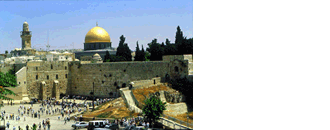
|
|
|
|
|
Class Prep
|
|
|
|
Building a House of G*d

- The primary readings for today concentrate on the Temple in Jerusalem—originally built under David/Solomon when the Yahwists wrote, destroyed by the Babylonians in 587 BCE, rebuilt under the Persians by 520 BCE, and managed by the priests thereafter. Since the First and Second Temples were the pre-eminent "sacred space" for the Jews in the past, I'd like you to reflect for your journal today on what the phrase "sacred space" means to you. Are there any places you consider sacred? That term "sacred" needn't mean in the religious sense, but rather in its root sense of "set apart," a place that takes you beyond yourself in a way that nevertheless unifies or integrates you. What makes the space sacred? Is it a place that you've made or shaped in some way?
-
- Genesis 1-3 preserves two accounts of creation that tell us less about a purported historical event
than they do about the Yahwist and Priestly worldviews. Read Levenson before reading these stories so that you're primed to understand what they might symbolize, and consider the following questions:
-
- Levenson refers to an idea first laid out by Richard Clifford, that the Jerusalem Temple on Mount Zion was understood to be a "cosmic mountain." In Clifford's and Levenson's view, what are the five characteristics of a cosmic mountain? Be able to discuss each.
- What actually takes place in the Temple? What do people and priests do there? (see p. 126 and following)
- How is the Jerusalem Temple connected to the Garden of Eden in the Yahwist account of creation (Genesis 2:4b-25)? Does the Priestly version of creation (Genesis 1:1–2:4a) make any such connections?
-
- The Priestly writers of the post-exilic period also wrote Leviticus, and Ezra was written by another person about the same time (5th century BCE). As you read both, identify the issues that matter to both authors as they try to rebuild their country. Then read Daniel. You'll think it's out of order, because the story takes place during the Babylonian Exile (587-539 BCE), thus well before the Priestly writers or Ezra. But this book was actually written around 166 BCE, under a Greek rather than the Persian Empire, and in a situation of crisis rather than a context of rebuilding. Do you see any evidence of that crisis in this apocalyptic story? The short piece by Carr and Conway on Camino will help you to answer that (it's in Lessons > Required Readings).
-
- One other thing besides the Temple that holds most of these readings together is they are all addressing the issues of theodicy (God's justice) and Jewish identity in the face of new and challenging circumstances. We'll discuss that more in class.
-
-
- Assigned Readings
-
- Primary: Genesis 1–3; Leviticus 19; 25; Ezra 1; 9; Daniel 2; 7
-
- Secondary: Swenson, Bible Babel 38-40 top; Levenson, Sinai and Zion 111-37; David M. Carr and Colleen M. Conway, excerpt from "Hellenistic Empires and the Formation of the Hebrew Bible," in An Introduction to the Bible: Sacred Texts and Imperial Contexts (Malden, Massachusetts: Wiley-Blackwell, 2010) 207-216 (Camino)
-
-
- Slides from Lecture
-
-
- Further Reading
-
- Bar, Doron. "Wars and Sacred Space: The Influence of the 1948 War on Sacred Space in the State of Israel." In Holy Places in the Israel-Palestinian Conflict (ed. Marshall J. Breger, Yitzak Reiter and Leonard M. Hammer; New York: Routledge, 2010) 67-91.
-
- Eliyahu, Eyal Ben. "The Rabbinic Polemic against Sanctification of Sites." Journal for the Study of Judaism 40 (2009) 260-80.
-
- Kahera, Akel Ismail. "Gardens of the Righteous: Sacred Space in Judaism, Christianity and Islam." Cross Currents 52:3 (2002) 328-41.
-
- Kedar, Benjamin Z. and R. J. Zwi Werblowsky, eds. Sacred Space: Shrine, City, Land: Proceedings from the International Conference in Memory of Joshua Prawer held in Jerusalem, June 8–13, 1992. New York: New York University Press, 1998.
-
- Miller, Patrick D. The Religion of Ancient Israel, Library of Ancient Israel. Louisville: Westminster John Knox, 2000.
-
- Walker, Seth. "My[sacred]Space: Discovering Sacred Space in Cyberspace." Journal of Religion and Popular Culture 22:2 (2010), online, http://www.usask.ca/relst/jrpc/art22(2)-mysacredspace.html.
-
-
-
- Links
- What Is Beneath Temple Mount? - A Smithsonian.com article by Joshua Hammer (Smithsonian magazine, April 2011) that provides a nice introduction to the archaeology and history of the site.
- The Noble Sanctuary - An online guide to Al-Haram al-Sharif in Jerusalem, that is, to the Muslim holy sites built on top of Temple Mount by the Umayyad Khalif, 'Abdul Malik ibn Marwan, in 685 CE.
- Temple Mount & Eretz Yisrael Faithful Movement - the website of a Jewish group that hopes to build a third Temple on Temple Mount in the present day The Mount is currently controlled by Palestinian Muslims, so this goal is a source of political/religious tension in Jerusalem.
- On the Road to Armageddon - an article by Timothy P. Weber on BeliefNet.com that explains how and why Christian evangelicals in the US support not only the state of Israel but also the rebuilding of the Temple on Temple Mount.
-
-
- Sources
- Photographs:
- "Model of Temple of Jerusalem after Herod's Expansion." Photograph by Bojan Brecelj, Jerusalem, Israel; reproduced online and copyright by Corbis Images,http://www.corbisimages.com.
|
|
|
|
|
